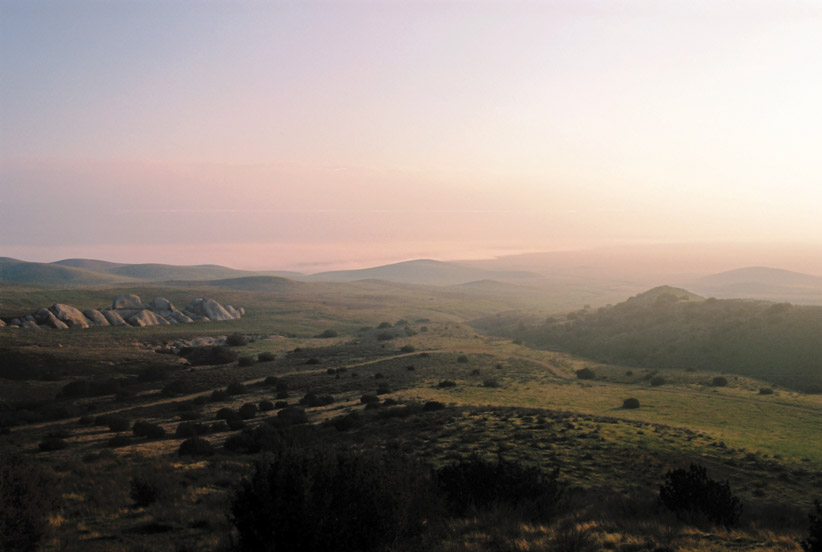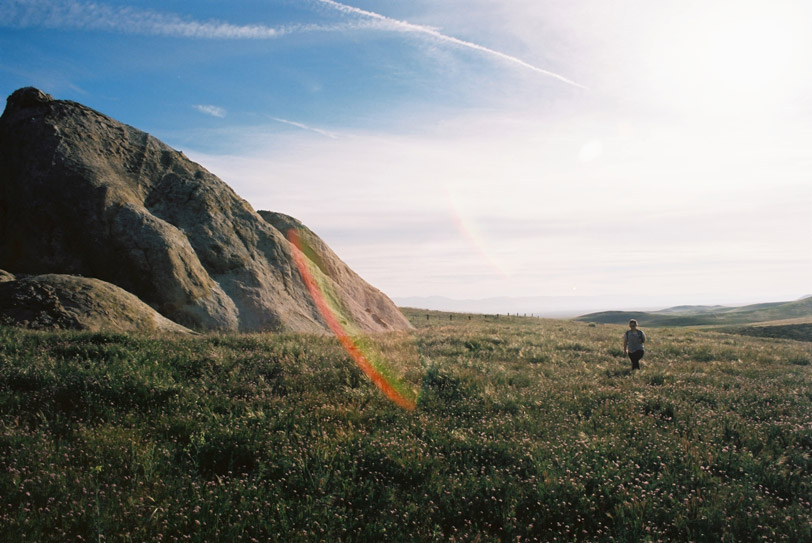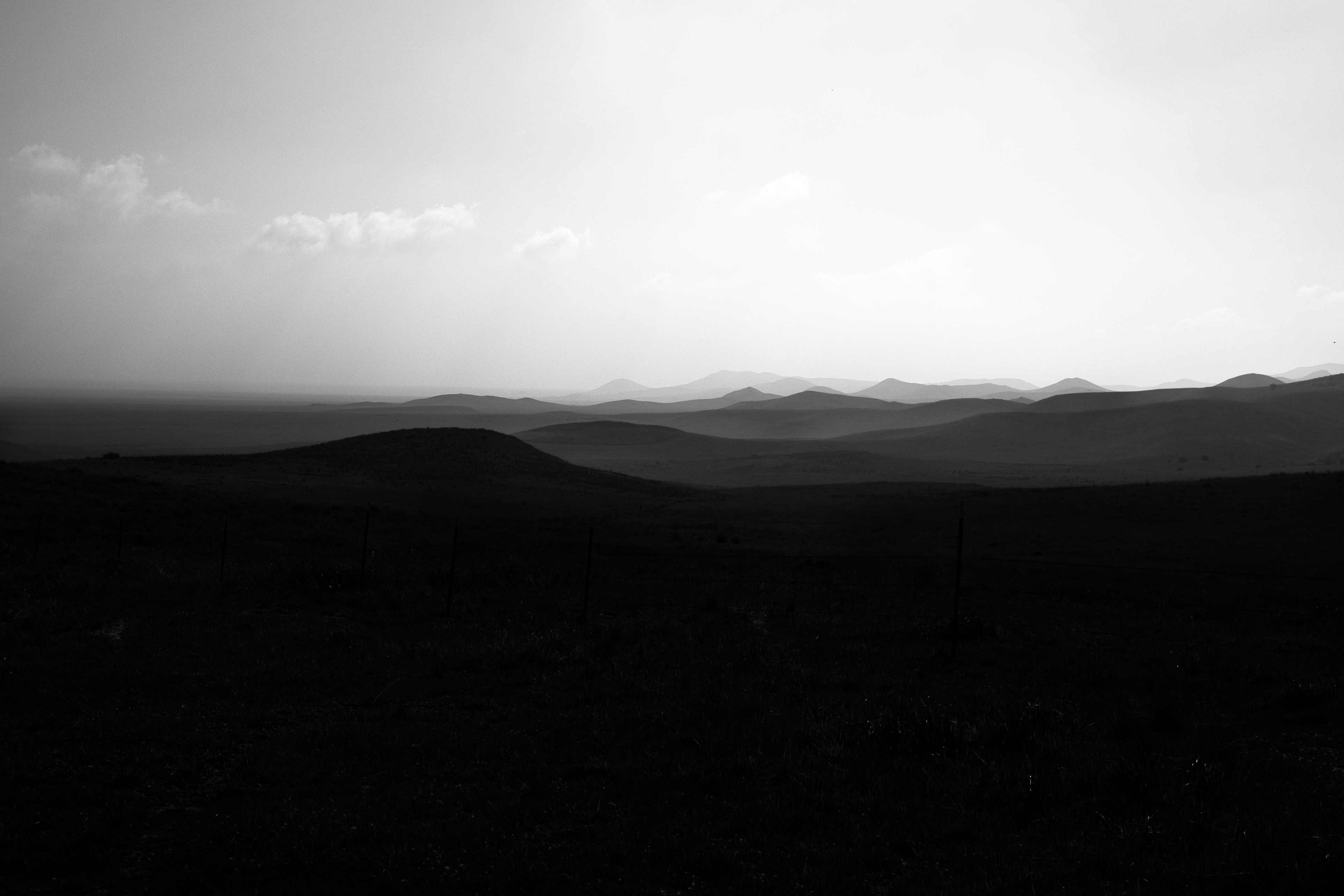
In the two and half hours it takes to drive to the Carrizo Plain, you go back in time about 300 years. Maybe 10,000, should you be lucky enough to check out the Chumash pictographs and rock paintings, said to be some of the most dazzling on the planet. Reservations, by the way, are required and for good reason. Back in the 1920s, much of the rock paintings were vandalized by gun-toting visitors who apparently believed the best way to appreciate native art was by shooting it.
Such insanity aside, there’s something reassuringly prehistoric about the Carrizo Plain. Big. Vast. Immense. Sweeping, powder-blue skies. Oceanic stretches of uninterrupted grasslands. The hills there don’t just roll; they roll their hips. They dance. They dip. There’s a geological friskiness to the land, however quiet, that makes you want to play. It invites you to get your nose up into the face of the San Andreas Fault, which runs along the backside of monument. The sense of sweltering stillness—so overpowering—is in some ways a great optical illusion.
There’s only one main drive—Soda Lake Road—that runs the length of the valley floor, named after a globular lake with such a high alkaline content it looks packed with snow. Maybe half of that 37-mile stretch is paved. The drivability of the rest depends on when it last rained and what kind of vehicle you’re driving. To one side stand Caliente Mountain; to the other, the Temblor Range. Both are best absorbed in the light of dawn or dusk. The Tremblors, in particular, have been carved and sculpted over time; all that detail dances in the sway of evening shadows.
The solitude and silence are all enveloping. On the low end of the subliminal sound spectrum is the cotton candy thrum of wind, nonstop and ubiquitous. On the higher end is the zing of passing flies — sharp and stinging — drawn by the occasional cow patties. Then there’s the silence of the big ropey waves of heat rolling through. Somehow, the enormous All Thisness of the Carrizo Plain does not crush the spirit. It does not suggest — as other vast places do — “You do not matter.” Instead, this landscape — uncompromisingly austere — somehow manages to be inviting. Hang out. Visit. But upon departure, understand better the keen with which Planet Earth tolerates members of the Homo sapiens cult.
Even at 246,000 acres, the Carrizo Plain National Monument qualifies as a small but significant remnant of what was once one of the world’s great grasslands — an American Serengeti — that for many millennia defined California’s San Joaquin Valley. To preserve what’s left was the impetus behind former president Bill Clinton’s decision to designate it a National monument in 2001. But two months ago, President Donald Trump issued an executive order empowering Secretary of Interior Ryan Zinke to thoroughly review all 27 national monuments that were designated since 1996 and span at least 100,000 acres to determine whether the existing boundaries be maintained, pared down, or eliminated altogether. That review is still ongoing.
The national monument law known as the Antiquities Act, created in 1906 at the instigation of then-president Teddy Roosevelt, gave the president power to bypass Congress and unilaterally protect wildlife and wilderness treasures. Zinke, who claims to be an enthusiastic adherent of Teddy Roosevelt’s outdoors-loving tradition, has complained that the amount of acreage being designated has recently increased at an alarming rate.
The National monument law turned 111 on June 8, and to celebrate, Santa Barbara Congressmember Salud Carbajal mailed a stern letter to Zinke warning that any effort to adjust the boundaries of Carrizo Plain National Monument “will be vigorously opposed.” “It’s a real-deal threat,” he later said, and he intends to meet with Zinke — whose wife grew up in Santa Barbara and whose family owns property here — to discuss the matter. The boundaries for Carrizo Plain, Carbajal said, had been carefully vetted and an environmental review conducted well before Clinton’s executive action. Congressmember Lois Capps — Carbajal’s predecessor — had introduced legislation in 1999 to declare the Carrizo Plain a national monument. Although that bill failed, it had been endorsed by Republicans Jerry Lewis and Bill Thomas, who represented Kern County, where large portions of the Carrizo Plain are located. Carbajal cited that bipartisan support in his letter to Zinke. He also cited the economic benefit to surrounding communities from the increased tourism generated by Carrizo Plain.

The same day Carbajal sent his letter, California Attorney General Xavier Becerra — one of Carbajal’s political mentors — delivered an 11-page ultimatum declaring that the president lacked the constitutional authority to repeal or change a national monument once it’s been designated. That power, he declared, resides exclusively with Congress. Should Trump — or Zinke — seek to modify the boundaries of any of California’s six national monuments, he vowed swift legal action.
Neil Havlik, a longtime member of Friends of the Carrizo Plain and an urban planner by profession, takes seriously the potential threat posed by the executive order, but his concerns are more nuanced. Oil companies hold claims on about half the monument’s acreage, he said, but that’s hardly new. Multiple efforts to find black gold have ended with dry holes. A small amount of oil is currently being pumped out of the Russell Ranch, located within the monument boundaries, and there’s an application to expand development. But all that, Havlik said, falls within the management plan painfully hammered out about 10 years ago by competing interests with a stake in the plains.
Roger Gambs, a longtime champion of the Carrizo Plain, said the executive action “does not bode well” for an ecosystem that’s home to 70 animal species that have been designated as rare, threatened, or endangered by state or federal agencies and 36 species of plants that are similarly designated.
Until the 1980s, much of the monument was owned by Oppenheimer Industries, headquartered in Missouri and operated mostly as a tax-shelter for well-heeled investors looking to offset their wealth for tax purposes. After the company founder died in the 1980s, the Nature Conservancy — working with the Bureau of Land Management (BLM) and California Department of Fish and Game — began acquiring chunks of Carrizo land. After Clinton declared it a national monument in 2001, the really hard part — fashioning a management plan — began in earnest. The first administrator for the BLM, Marlene Braun, sought to cut back grazing, which put her at serious cross purposes with those up the political food chain — appointed by then-president George W. Bush. Famously, in 2005, Braun shot herself after first killing her two dogs. The Carrizo management strife contributed significantly. Although it took years for that dust to settle, a management plan was finally adopted, and today, grazing is the key tool by which the biomass of grasslands is maintained. Cows are allowed, but their feeding is calibrated to allow grazing space for other species.
Ironically, the most immediate impact of the management plan was the disappearance of the iconic Sandhill cranes whose annual mass migration to Soda Lake was spectacular. Every year, bird watchers thronged to watch as thousands of cranes arrived. Attracting the cranes, it turned out, were the nearby barley fields that had been dry-farmed in the valley bottom. When the management plan phased out the barley, the cranes were forced to seek nourishment elsewhere. As result, the cranes no longer reign mainly on the Carrizo Plain.
As far as Havlik’s concerned, the Carrizo Plain is just fine as it is. “It’s big. It’s remote. There’s a quality of serenity you get from being there,” he said. “You go out there, and you look around and just go, “Wow!’”
Editor’s Note: This story was corrected on June 20 to state that Oppenheimer Industries is in Missouri, not Oklahoma.




